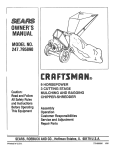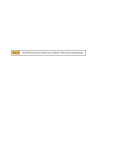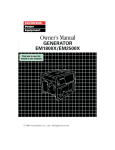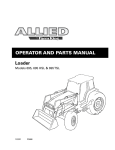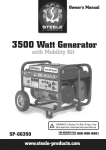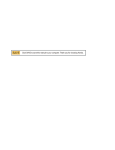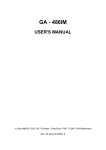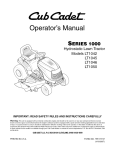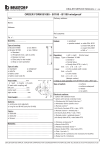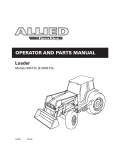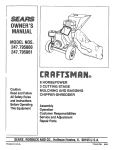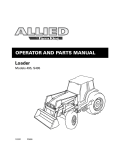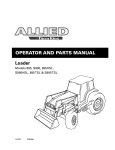Download Honda Power Equipment GXV670 Automobile Parts User Manual
Transcript
Click SAVE to save this manual to your computer. Thank you for choosing Honda. ENGINES Owner’s Manual GXV610 GXV620 GXV67O The engine exhaust from this product contains chemicalsknown tothe State of California to cause cancer, birth defects or other reproductive harm. Keep this owner's manual handy, so you can refer to it at any time. This owner's manual is considered a permanent part of the engine and should remain with the engine if resold. The information and specifications included in this publication were in effect at the time of approval for printing. Illustrations are based on the GXV61O-OAF type. Honda Motor Co., Ltd. reserves the right, however, to discontinue or change specifications or design a t any time without notice and without incurring any obligation whatever. No part of this publication may be reproduced without written permission. Congratulations on your selection of a Honda engine. We are certain you will be pleasedwith your purchase of one of the finest engines on the market. We want to help you get the best results from new your engine and to operate it safely. This manual contains the information on how to do that; please readit carefully. As ou read this manual, you will find information preceded by a symbol.Thatinformationisintended to helpyouavoid damage to yourengine, other property, or the environment. Wesuggest you read thewarrantypolicy tofullyunderstandits coverage and your responsibilities of ownership. The warranty policy is a separate document that should have been given to you by your dealer. When your engine needs scheduled maintenance, keep in mind that your Honda servicing dealer is specially trained in servicing Honda engines. Your Honda servicingdealer is dedicated to yoursatisfaction and will be pleasedto answer your questionsand concerns. Best Wishes, Honda Motor Co., Ltd. 1 INTRODUCTION A FEW WORDS ABOUTSAFETY Your safety and the safety of others are very important. And using this engine safely is an important responsibility. To help you make informed decisions aboutsafety, we have provided operatingproceduresandotherinformationonlabelsandinthis manual. This information alerts you to potential hazards that could hurt you or others. Of course, it is not practical or possible to warn you about all the hazards associated with operating or maintaining an engine. You must use your own good judgment. You willfindimportant including: safetyinformationin a varietyofforms, A and one Safety Messages - preceded by a safety alert symbol of three signal words, DANGER, WARNING, or CAUTION. These signal words mean: You WILL be KILLED or SERIOUSLYHURT if you don’t follow instructions. You CANbeKILLED or SERIOUSLYHURT you don‘t follow instructions. if You CAN be HURT if you don’t follow instructions. Safety Headings - such as IMPORTANTSAFEWINFORMATION. Safety Section - such as ENGINE SAFETY. Instructions - how touse this engine correctly and safely. This entire book is filled with important safety information - please read it carefully. 2 ENGINE SAFETY ........................................................................................ IMPORTANT SAFETY INFORMATION ................................................. 5 5 CONTROLS & FEATURES ......................................................................... COMPONENT & CONTROL LOCATIONS ............................................. CONTROLS ........................................................................................... Choke Lever ...................................................................................... Throttle Lever ................................................................................... Recoil Starter Grip............................................................................ FEATURES ............................................................................................ Fuel-cut Solenoid ............................................................................. Oil Cooler (GXV670)......................................................................... 7 7 10 10 11 11 12 12 12 BEFORE OPERATION .............................................................................. IS YOUR ENGINE READY TOGO? ...................................................... Check the General Condition of the Engine ................................... Check the Engine .............................................................................. Check the Equipment Poweredby This Engine ............................. 13 13 13 14 14 OPERATION ............................................................................................. SAFE OPERATING PRECAUTIONS .................................................... STARTING THE ENGINE ..................................................................... STOPPING THE ENGINE ..................................................................... SETTING ENGINE SPEED .................................................................... 15 15 15 18 19 SERVICING YOUR HONDA ENGINE ...................................................... 20 THE IMPORTANCE OF MAINTENANCE ............................................. 20 MAINTENANCE SAFETY ..................................................................... 21 MAINTENANCE SCHEDULE ............................................................... 22 FUEL RECOMMENDATIONS .............................................................. 23 ENGINE OIL LEVEL CHECK ................................................................. 24 ENGINE OIL CHANGE .......................................................................... 25 OIL FILTER CHANGE ............................................................................ 26 ENGINE OIL RECOMMENDATIONS ................................................... 28 AIR FILTER INSPECTION ..................................................................... 29 AIR CLEANER SERVICE ....................................................................... 30 FUEL FILTER INSPECTION .................................................................. 32 SPARK PLUG SERVICE ........................................................................ 33 SPARK ARRESTER MAINTENANCE (optional equipment)..............35 3 CONTENTS HELPFUL TIPS& SUGGESTIONS .......................................................... STORING YOUR ENGINE .................................................................... Storage Preparation ......................................................................... Storage Precautions ......................................................................... Removal From Storage .................................................................... TRANSPORTING .................................................................................. 37 37 37 40 41 42 TAKING CARE OF UNEXPECTED PROBLEMS ...................................... ENGINE WILL NOT START .................................................................. ENGINE LACKS POWER ...................................................................... 43 43 43 TECHNICAL & CONSUMER INFORMATION ......................................... 44 TECHNICAL INFORMATION ................................................................ 44 Serial Number Location ................................................................... 44 Battery Connectionsfor Electric Starter ......................................... 45 46 Remote Control Linkage .................................................................. Carburetor Modification for High Altitude Operation ...................47 48 Oxygenated Fuels ............................................................................ Emission Control System Information........................................... 49 Air Index ............................................................................................ 51 52 Specifications ................................................................................... Wiring Diagrams .............................................................................. 54 CONSUMER INFORMATION ............................................................... 57 57 Honda Publications .......................................................................... Warranty Service Information ......................................................... 58 QUICK REFERENCE INFORMATION ............................. 4 Inside back cover IMPORTANT SAFETY INFORMATION Most accidents with enginescanbeprevented if youfollow instructionsinthismanualandontheengine.Someofthemost common hazards are discussed below, along with the best way protect yourself and others. all to Owner Responsibilities Honda engines are designed to give safe and dependable service if operated according to instructions. Read and understand this owner’s manual before operating the engine. Failureto do so could result in personal injury or equipment damage. Know how to stop the engine quickly, and understand the operation of all controls. Never permit anyone to operate the engine without proper instructions. Do not allow children to operate the engine. Keep children and pets away from thearea of operation. Refuel With Care Gasoline is extremely flammable, and gasoline vapor can explode. Refuel outdoors, in a well-ventilated area, with the engine stopped. Never smoke near gasoline, and keep other flames and sparks away. Always store gasoline in an approved container. Ifany fuel is spilled, make sure thearea is dry before starting the engine. Hot Exhaust The muffler becomes very hot during operation and remains hot for a while after stopping the engine. Be careful not to touch the muffler while it is hot. Let the engine cool before storing it indoors. Topreventfire hazards andtoprovideadequateventilationfor stationary equipment applications, keep the engine a t least 3 feet (1 meter)awayfrombuildingwallsandotherequipmentduring operation. Do not place flammable objects closeto theengine. 5 ENGINE SAFETY Carbon Monoxide Hazard Exhaust gas contains poisonous carbon monoxide. Avoid inhalation of exhaust gas. Never run the engine in a closed garage or confinedarea. Other Equipment Review the instructions provided with the equipment powered by this engine for any additional safety precautions that should be observed inconjunctionwithenginestartup,shutdown,oroperation,or protective apparel that maybe needed to operate the equipment. COMPONENT & CONTROL LOCATIONS ( GXV61O/GXV620 ) FAN COVER PROTECTOR TYPE PROTECTOR TYPE RECOIL EQUIPPED TYPE GRID (STANDARD TYPE) I I STARTER GRIP (QWA type only) OIL PRESSURE SWITCH AIR FILTER FUEL SPARK PLUG 7 CONTROLS & FEATURES ELECTRIC S SPARK PLUG \ MUFFLER 8 CONTROLS & FEATURES ( GXV670 ) OIL PRESSURE SWITCH AIR / FUEL FILTER I SPARK PLUG OIL COOLER SPARK PLUG 9 CONTROLS & FEATURES CONTROLS Choke Lever The choke lever opens and closes the choke valve in the carburetor. The CLOSED positionenrichesthefuelmixtureforstartingacold engine. The OPEN position provides the correct fuel mixture for operation after starting, andfor restarting a warm engine. Some engine applications use a engine-mounted choke control rather thantheremote-mountedchokelevershown here. Refer to the instructions provided with the equipment powered by this engine for remote control information. CHOKE LEVER CLOSED 10 - Throttle Lever The throttle lever controls engine speed. Moving the throttle lever in run faster or slower. the directions shown makes the engine Someengineapplicationsusearemotely-mountedthrottlecontrol rather than the engine-mounted throttle lever shown here. Refer to the instructions provided with the equipment powered by this engine for remote control information. THROTTLE LEVER . SLOW Recoil Starter Grip (QWA type) Pulling the starter grip operates the recoil starter to crank the engine. STARTER GRIP 11 CONTROLS & FEATURES FEATURES Fuel-cut Solenoid The engine is equipped with a fuel-cut solenoid that allows fuel to flow to the carburetor main jet when the engine switch is in the ON or START position and stops the flow of fuel to the main jet when the engine switch is in the OFF position. The engine must be connected to the battery to energize the fuel-cut solenoid, allowing the engine to run. If the battery is disconnected, fuel flow to the carburetor main willjet stop. Oil Cooler (GXV670) The GXV670 engine is equipped with an oil cooler to maintain the correct oil temperature. 12 IS YOUR ENGINE READY TO GO? For your safety, and to maximize the service life of your equipment,it is very important to takea fewmomentsbeforeyouoperatethe engine to check its condition. Be sure to take care of any problem you find, or have your servicing dealer correct it, before you operate the engine. Improperly maintaining thisengine, or failingto correct a problem before operation, could causea malfunction in which you could be seriously injured. Always perform a preoperation inspection beforeeach operation, and correct any problem. Before beginning your preoperationchecks, be sure the engine is level and the engine switch in isthe OFF position. Check the General Conditionof the Engine Look around and underneath the engine for signs oil of or gasoline leaks. Remove any excessive dirt or debris, especially around the muffler and recoil starter. Look for signs of damage. Check that all shields and covers are in place, and allnuts, bolts, and screws are tightened. 13 BEFORE OPERATION Check the Engine Check the engine oil level (see page 24). Running the engine with a low oil level cancause engine damage. Check the air filter(see page29). A dirty air filterwill restrict airflow to thecarburetor, reducing engine performance. Check the fuel level. Starting witha full tank will help to eliminate or reduce operating interruptions for refueling. Check the Equipment Poweredby This Engine Review the instructions providedwith the equipment powered by this engine for any precautions and proceddres that should be followed before engine startup. 14 SAFE OPERATING PRECAUTIONS Before operating the engine for the first time, please review the IMPORTANT SAFETY INFORMATION on page 5 and the chapter titled BEFORE OPERA TION. Carbon monoxidegas is toxic. Breathing it can cause unconsciousness and even kill you. Avoid anyareas or actions that expose you tocarbon monoxide. Review the instructions provided with the equipment poweredby this engineforanysafetyprecautionsthatshouldbeobserved in conjunction with enginestartup, shutdown, or operation. STARTING THE ENGINE 1. If the fuel tank is equipped with a valve, be sure the fuel valve is in the OPEN or ON position before attempting to start the engine. 15 OPERATION 2. To start a coldengine, pull thechoke lever to theCLOSED position. To restart awarm engine, leave the choke lever in the OPEN position. Someengineapplications usean engine-mountedchokecontrol rather than the remote-mounted choke lever shown here. Refer to theinstructionsprovidedwiththeequipmentpoweredbythis engine for remote control information. . CHOKE LEVER . CLOSED 3. Move the throttle lever away from theSLOW position, about 1/3 of the way toward the FAST position. Some engine applications use an engine-mounted throttle control rather than the remote-mounted throttle lever shown here. Refer to theinstructionsprovidedwiththeequipmentpoweredbythis engine for remote control information. SLOW 16 OPERATION 4. Turn the engine switch to ON the position. 5. Operate the starter. RECOIL STARTER(applicable enginetypes): Pull the starter grip lightlyuntil you feel resistance, then pull briskly. Return the starter grip gently. STARTER GRIP ELECTRIC STARTER (all engine types): Turn thekey to theSTART position, and holdit there until the engine starts. If the engine fails to start within 5 seconds, release the key, and wait at least 10 seconds before operating the starter again. m Using the electric starter for more than 5 seconds at a time will overheat thestarter motor andcan damageit. When the engine starts, release the key, allowing it to return to the ON position. 6. If the choke lever has been moved to the CLOSED position to start the engine, gradually move it to the OPEN position as the engine warms up. CHOKE LEVER CLOSED 17 OPERATION STOPPING THE ENGINE To stop the engine in an emergency, simply turn the engine switch to the OFF position. Under normal conditions, use the following procedure. 1. Move the throttle lever to the SLOW position. Some engine applications use an engine-mounted throttle control rather than the remote-mounted throttle lever shown here. Refer to theinstructionsprovidedwiththeequipmentpowered by this engine for remote control information. THROTTLE LEVER \ p - rw SLOW 2. Turn the engine switch to the OFF position. 3. If the fuel tank is equipped with a valve, turn the fuel valve to the CLOSED or OFF position. 18 OPERATION SElTlNG ENGINE SPEED Position the throttle lever for the desired engine speed. Someengineapplications use an engine-mountedthrottlecontrol rather than the remote-mounted throttle lever shown here. For engine speed recommendations, referto the instructions provided with the equipment powered by this engine. THROlTLE LEVER , SLOW Do not disconnect the battery from the engine while the engine is running. Disconnecting the battery causes the fuel-cut solenoidto shut off the flow of fuel to the carburetor jet, main and the engine will stop. 19 SERVICING YOUR HONDA ENGINE THE IMPORTANCE OF MAINTENANCE Good maintenance is essential for safe, economical, and trouble-free operation. It will also help reduce air pollution. Improperly maintaining :his engine, or failure to correct a problem before operation,can c a x e a malfunction in which youcan be seriously hurt or killed. Always follow the inspection and maintenance recommendations and schedules in thisowner‘s manual. To help you properlycare for your engine, the following pages include a maintenance schedule, routine inspection procedures, and simple maintenance procedures using basic hand tools. Other service tasks that are more difficult, or require special tools, are best handled by professionals and are normally performed by a Honda technician or other qualified mechanic. The maintenance schedule applies to normal operating conditions. If you operate your engine under unusual conditions,such as sustained high-load or high-temperature operation, or use in unusually wet or dusty conditions, consult your servicing dealer for recommendations applicable to your individual needs and use. Maintenance, replacement or repair of emission control devices and systems maybe done by any engine repair establishment or individual, using parts that are “certified”’t0 EPA standards. 20 SERVICING YOUR HONDA ENGINE MAINTENANCE SAFETY Some of the most important safety precautions follow. However, we cannotwarnyouofeveryconceivable hazard that canarise in performing maintenance. Only you can decide whether or not you should perform a given task. Failure to properly follow maintenance instructions and precautions cancause you to be seriously hurt orkilled. Always follow the procedures and precautions in the owner’s manual. Safety Precautions Make sure the engine is off before you begin any maintenance or repairs. This will eliminate several potential hazards: -Carbon monoxide poisoning from engine exhaust. Be sure there is adequate ventilation whenever you operate the engine. -Burns from hot parts. Let the engine and exhaust system cool before touching. -Injury from moving parts. Do not run the engine unless instructed toso.do Read the instructions before youbegin, and make sureyou have the tools and skills required. To reducethepossibilityoffireorexplosion,becarefulwhen workingaroundgasoline. Use only a nonflammable solvent, not gasoline, to clean parts. Keep cigarettes, sparks and flames away from all fuel-related parts. Remember that your servicing dealer knows your engine best and is fully equipped to maintain and repair it. To ensurethebestqualityandreliability,useonly new, genuine Honda partsor their equivalents for repair and replacement. 21 MAINTENANCE SCHEDULE Refer 0 1 l o ! I 33 l o ~ I I Fuel tank Fuel tube Clean Check I 25 After Every year (2) Even/ 2 years (Replace if necessary) (2) - 1 - Emission-related items. * Replace the paper air filter element only. (1) Service more frequently when usedin dusty areas. (2) These items should be serviced by your servicing dealer, unless you have the proper tools and are mechanically proficient. Refer to theHonda shop manual for service procedures. (3) For commercial use, log hours of operation to determine proper maintenance intervals. 22 SERVICING YOUR HONDA ENGINE FUEL RECOMMENDATIONS Use unleaded gasoline with a pump octane rating of 86 or higher. These engines are certifiedt o operate on unleaded gasoline. Unleaded gasoline produces fewer engine and spark plug deposits and extends exhaust system life. Never use stale or contaminated gasoline or an oil/gasoline mixture. Avoid getting dirt or water in the fueltank. Occasionally youmay hear a light "sparkknock" or"pinging" (metallic rapping noise) while operating under heavy loads. This n iso cause for concern. Ifsparkknock orpingingoccursat a steadyengine normal load, change brands of gasoline. If spark knock or persists, see an authorized Honda servicing dealer. speed, under pinging m Running the engine with persistent spark knock or pinging can cause engine damage. Running the engine with persistent spark knock or pinging is misuse, and the Distributor's Limited Warrantydoes not cover parts damaged by misuse. 23 SERVICING YOURHONDA ENGINE ENGINE OIL LEVEL CHECK Check theengineoillevel position. with theenginestoppedandin a level 1. Place the engine on a level surface. 2.GXV670 ONLY: Start the engine and let it idle for 1 or 2 minutes. Stop the engine and wait for 2 or 3 minutes. 3. Remove the oil filler cap/dipstick and wipe it clean. 4. Insert and remove the dipstick without screwing it into the oil filler neck. Check the oil level shown on the dipstick. 5. If the oil level is near or below the lowerlimit mark on the dipstick, fill with the recommended oil to the upperlimit mark (see page 28). 6. Reinstall the oil filler cap/dipstick. OIL FILLER CAP/ DIPSTICK / OIL FILLER CAP/ / - UPPER LIMIT -LOWER LIMIT piZq Running the enginewith a low oil level can causeengine damage. 24 SERVICING YOUR HONDA ENGINE ENGINE OIL CHANGE Drain the used oil while the engine is warm. Warm oil drains quickly and completely. 1. Place a suitable container below the en ine to catch the used oil, then remove the oil filler cap/dipstickCYthe an drain bolt. 2. Allow the used oil to drain completely, then reinstall the drain bolt, and tightenit securely. Please dispose of used motor oil in a manner that is compatible with the environment. We suggest you take used oil in a sealed container toyourlocalrecyclingcenterorservicestationfor reclamation. Do not throwit in the trash, pour it on the ground, or down a drain. 3. With the engine in a level position, fill to the upper limit mark on the dipstick with the recommended (see oil page 28). ENGINE OIL REFILL CAPACITIES: Without oil filter replacement: GXV61OIGXV620 GXV670 With oilfilter replacement: GXV61O/GXV620 GXV670 1.8 US qt (1.7 Q , 1.5 Imp qt) 2.1 US qt (2.0 Q , 1.8 Imp qt) 2.3 US qt (2.2 0, 1.9 Imp qt) 2.6 US qt (2.5 Q ,2.2 Imp qt) p q i Running the engine with a low oillevel can causeengine damage. 4. Reinstall the oil filler cap/dipstick securely. UPPER LIMIT LOWER LIMIT OIL DRAIN BOLT OIL FILLER CAPIDIPSTICK 25 SERVICING YOUR HONDA ENGINE OIL FILTER CHANGE 1. Drain the engine oil, and retighten the drain bolt securely(see page 25). 2. Remove the oil filter with oil filter wrench, and drain the remaining oil into a suitable container.Discard the used oil filter. [NOTlCE] Use an oil filter socket, rather than a strap wrench, to avoid striking and damaging the filter. oil OIL FILTER / OIL FILTER SOCKET SEAL 3. Clean the filter mountingbase, and coat theseal of the new oil filter with clean engineoil. p E i K \ Use only a genuine Honda oil filter or a filter of equivalent quality specified for your model. Using the wrong filter, or a non-Honda filter whichis not ofequivalent quality, may cause engine damage. 26 4.Screw on the new oil filter by hand until the seal contacts the filter mounting base, then use an oil filter wrench to tighten the filter an additional 7/8 turn. Oil filter tightening torque: 16 Ibf-ft (22 N - m , 2.2 kgf-m). 5. Refill the crankcase with the specified amount of the recommended oil (see page28). Reinstall the oil filler cap/dipstick. 6. Start theengine, and check for leaks. 7. Stop the engine, and check the oil level as described on page 24. If necessary, add oil to bring the oil level to the upper limit mark on t dipstick. 27 SERVICING YOUR HONDA ENGINE ENGINE OIL RECOMMENDATIONS Oil is a major factor affecting performance and service life. Use 4-stroke automotive detergent oil. SAE IOW-30 is recommended for generaluse. Other viscosities shown in the chart may be used whenaverage the temperature in your area is within the recommended range. SAE TEMP -20 0 20 40 60 80 100°F -30 -20 -10 0 10 20 30 40'C AMBIENT TEMPERATURE The SAE oil viscosity and service classification are in the API label on theoilcontainer.Hondarecommendsthatyouuse API SERVICE category SJ oil. 28 SERVICING YOUR HONDA ENGINE AIR FILTER INSPECTION Remove the air cleaner cover and inspect the filter elements. Clean or replace dirty filter elements. Always replace damaged filter elements. Refer to page30for instructions that apply to the air cleaner and filter service. AIR CLEANER BASE SPRING TABS I I PAPER FILTER ELEMENT ' SPRING TABS FOAM FILTER ELEMENT CLEAN CHAMBER AIR CLEANER COVER 29 SERVICING YOUR HONDA ENGINE _ _ ~ AIR CLEANER SERVICE A dirty air filterwill restrict air flow to the carburetor, reducing engine performance. If you operate the engine in very dusty areas, clean the air filter more often than specified inMAINTENANCE the SCHEDULE. (see page22). p E - 1 Operating the enginewithout an air filter, or with adamaged air filter, will allow dirt to enter the engine, causing rapid enginewear. This type of damage is not covered by the Distributor’s Limited Warranty. 1. Release the four spring tabs from the air cleaner cover, and remove the cover. 2. Remove the foam filter element. 3. Remove the paper filter element. AIR CLEANER BASE SPRING TABS G TABS PAPER FILTER ELEMENT FOAM CLEAN CHAMBER / AIR CLEANER COVER 4. InsDect bothairfilter eleme!nts, andreplacethemifthey are damaged. Always replace the paper filter element at the scheduled interval (see page 22). 30 5. Clean the air filter elements if they are to bereused. Paper filter element: Tap the filter element several times on a hard surface to remove dirt, or blow compressed air [not exceeding 30 psi (207 kPa, 2.1 kgf/cm2)] through the filter element from the clean side that faces the engine. Never try to brush off dirt; brushing will force dirt into the fibers. Replace the paper filter element ifit is excessively dirty. i Foam filter element:Clean in warmsoapy water, rinse, and allow to drythoroughly. Orclean innonflammablesolventandallowtodry. Do not apply oil to the foam element. 6. Wipe dirt from the inside of the air cleaner base and cover, using a moist rag. Be careful toprevent dirt fromenteringthe clean chamber thatleads on the carburetor. 7. Place thefoamairfilterelement in the aircleaner cover, then and cover to the aircleaner base. reinstall the paper air filter element Hook four spring tabs securely. 31 SERVICING YOURHONDA ENGINE FUEL FILTERINSPECTION 1. Remove the air cleaner cover and the paper filter elements (see page 30). 2. Remove thetwo 6 mm nuts and remove the air cleaner cap from the air cleaner base. 3. Remove the two5 mm special bolts andtwo 6 mm flange bolts from the aircleaner base and remove the air cleaner base. Remove the fuel filter clamped behind the air cleaner ba’se. PAPER FILTER ELEMENT AIR CLEANER BASE AIR CLEANER COVER 4. Check the fuel filter for water accumulation or sediment. If no water or sediment is found, reinstall thecleaner air base. L FILTER 5. If thefuelfilterisfoundwith excessive wateraccumulation or sediment, take the engine to yourauthorized Honda servicingdealer. 32 a t SERVICING YOUR HONDA ENGINE SPARK PLUG SERVICE Recommended spark plugs: ZGR5A (NGK) J 16CR-U (DENSO) m Incorrect spark plugs can cause engine damage. L 1. Disconnect the spark plug caps, and remove any dirt from around the spark plug area. 2. Remove the spark plugs witha 13/16-inch spark plug wrench. SPARK PLUG CAP SPARK PLUG WRENCH *’ 3. Inspect the spark plugs. Replace them if the electrodes are worn, oriftheinsulator is cracked or chipped. Clean the spark plugs with a wire brush if youare going to reuse them. 4. Measure the spark plug electrode gap with a suitablegauge. The g a p s h o u l d b e 0.028-0.031 i n (0.70-0.80 mm). Correct the gap, if necessary, by carefully bending the sideelectrode. 5. Install the spark plug carefully, by hand, to avoid cross-threading. 33 SERVICING YOUR HONDA ENGINE 6.Afterthesparkplug seats, tightenwitha wrench to compress the washer. If reinstalling the used spark spark plug seats. 13/16-inchspark plug plugs, tighten 1/8-1/4 turn after the If installing a new spark plugs, tighten 1/2 turn after the spark plug seats. A loose spark plug can overheat anddamage the engine. Overtighteningthe spark plug can damage thethreads cylinder head. 7. Attach the spark plug caps. 34 t * in the SPARK ARRESTER SERVICE(optional equipment) Your engine is not factory-equipped with a spark arrester. In some areas, it is illegal to operate an engine without a spark arrester. Check local laws and regulations. A spark arrester is available from authorized Honda servicingdealers. r' , The spark arrester mustbeservicedevery functioning as designed. 100 hoursto keep it If the engine has been running, the muffler will be very hot. Allow the muffler to cool before servicing the spark arrester. 1. Removethe 6 m m flange bolts from the muffler protector, and remove the muffler protector. 2. Remove the special screws from the spark arrester and remove the spark arresterfrom the muffler. SPARK ARRESTER SPECIAL SCREWS \ MUFFLER PROTECTOR 6 mm FLANGE BOLT 35 SERVICING YOUR HONDA ENGINE 3. Usea brush to remove carbon deposits from the spark arrester screen. Be careful to avoid damaging the screen. The spark arrester must be free of spark arrester ifit is damaged. breaks and holes. Replace the . / SPARK ARRESTER SCREEN 4. Install the spark arrester, and muffler protector in the reverse order of disassembly. 36 HELPFUL TIPS & SUGGESTIONS STORING YOUR ENGINE Storage Preparation Properstoragepreparationisessential for keeping yourengine troublefree and looking good. The following steps will help to keep rust and corrosion from impairing your engine's function and appearance, and will make the engine t o start easier when you use it again. Cleaning If the engine has been running, allowit to cool for atleast half an hour before cleaning. Clean all exterior surfaces, touch up any damaged paint, and coat other areas that may rustwith a light film of oil. Using a garden hose or pressure washing equipment can force water into the aircleaner or muffleropening. Water in the aircleaner will soak the air filter, andwater that passes through the air filteror muffler can enterthe cylinder,causing damage. Water contacting a hot engine can cause damage. If the engine has been running, allow it to cool for at least half an hour before washing. Fuel Gasoline will oxidizeanddeteriorate in storage.Oldgasoline will cause hard starting, and it leaves gum deposits that clog the fuel system. If the gasolinein your engine deteriorates duringstorage, you may need to have the carburetor and other fuel system components serviced or replaced. The length of time that gasoline can be left in your fuel tank and carburetor without causing functional problems will vary with such factors as gasoline blend, your storage temperatures, and whether the fuel tank is partially or completely filled. The airin a partially filled fuel tankpromotesfueldeterioration.Verywarmstoragehemperatures accelerate fuel deterioration. Fuel deterioration problems may occur within a few months, or even less if the gasoline was not fresh when you filled the fuel tank. 37 HELPFUL TIPS & SUGGESTIONS The Distributor’sLimitedWarranty does notcoverfuelsystem damageorengineperformanceproblemsresultingfromneglected storage preparation. You can extendfuelstoragelife by adcfng a fuelstabilizerthat formulatedforthatpurpose,oryou can avoidfueldeterioration problems by draining the fuel tank and carburetor. is e ADDING A FUEL STABILIZERTO EXTEND FUEL STORAGE LIFE Whenadding a fuel stabilizer, fillthefueltankwithfreshgasoline. If onlypartiallyfilled,airinthe tank willpromotefueldeterioration during storage. If you keep a container of gasoline for refueling, be sure that it contains only fresh gasoline. 1. Add fuel stabilizer following the manufacturer’s instructions. 2. After adding a fuel stabilizer, run the engine outdoors for 10 minutes to be sure that treated gasoline has replaced the untreated gasoline in the carburetor. 3.Stop the engine, and if the fuel tank is equipped with a fuel valve, move the fuel valve to CLOSED the or OFF position. 38 , DRAINING THE FUEL TANK AND CARBURETOR 1. Disconnect the fuel line to theengine, and drain the fuel tank into an approved gasoline container. If the fuel tank is equipped with a valve turn the fuel valve to the OPEN or ON position to enable draining. After draining is completed, reconnect the fuel line. 2. Loosen the carburetor drainscrew, and drain the carburetor into an approved gasoline container. After draining is completed, tighten the carburetor drain screw. Gasoline is highly flammable and explosive. You can be burned or seriously injured when handling fuel. Keep heat, sparks and flameaway. Handle fuel only outdoors. Wipe up spills immediately. CARBURETOR 39 HELPFUL TIPS& SUGGESTIONS Engine Oil 1. Change the engineoil (see page 25). Engine Cylinder 1. Remove the spark plugs (see page33). , 2. Pour a tablespoon(5- 10 cc) ofclean engine oil into the cylinders. 3. Pullthestarterropeseveraltimestodistributetheoilinthe cylinders. 4. Reinstall the spark plugs. Storage Preparation If yourengine will bestored with gasoline in thefueltankand carburetor, it is important to reducethe hazard ofgasolinevapor ignition. Select awell-ventilated storage area away from any appliance that operates with a flame, such as a furnace, water heater, or clothes dryer. Also avoid any area with a spark-producing electric motor, or where power toolsare operated. If possible, avoidstorage areas withhighhumidity, promotes rust and corrosion. because that Unless all fuel has been drained from thetank, fuel leave the fuel valve in the CLOSED or OFF position toreduce the possibility of fuelleakage. 40 HELPFUL TIPS& SUGGESTIONS Position the equipmentso the engine is level. Tilting can cause fuel or oil leakage. With the engine and exhaust system cool, cover the engineto keep out ormeltsome dust. A hotengine and exhaustsystemcanignite materials. Do not use sheet plasticas a dust cover. A nonporous cover will trap moisture around the engine, promoting rust and corrosion. X Ifinstalled,removethebatteryandstore it in a cool, dry place. Recharge the battery oncea month while the engine is in storage. This will help to extend the service life of the battery. Removal From Storage Check your engine as described in theBEFORE OPERATlONchapter of this manual. If the fuel was drained during storage preparation, fill the tank with fresh gasoline. If you keep a container of gasoline for refueling, be surethat it containsonlyfreshgasoline.Gasolineoxidizesand deteriorates over time, causing hard starting. If the cylinders were coated with oil during storage preparation, the engine may smoke brieflyat startup. This is normal. 41 HELPFUL TIPS& SUGGESTIONS TRANSPORTING If the engine has been running, allow it to cool for at least 15 minutes beforeloadingtheengine-poweredequipmentonthetransport vehicle. A hot engine and exhaust system can burn you and can ignite some materials. Keep the engine level when transporting to reduce the possibility of fuel leakage. If the fuel tank is equipped with a fuel valve, move the fuel valve leverto OFF. 42 ENGINE WILL NOT START 1. Check battery and fuse. 2. Check control positions. 3. Check fuel. 4. Remove and inspect spark plug. 5. Take engine to an authorized Honda servicing dealer, or refer to shop manual. ENGINE LACKS POWER 1. Check air filter. 2. Check fuel. 3. Take engine to an authorized Honda servicing dealer, or refer to shop manual. Possible Cause Correction Battery discharged. Fuse burnt out. (if equipped) Fuel valve OFF. (if equipped) Choke OPEN. Recharge battery. Replace fuse. Engine switchOFF. (if equipped) Out offuel. Bad fuel; engine stored without treating or draining gasoline, or refueled with bad gasoline. Spark plugs faulty, fouled, or improperly gapped. Spark plugs wet with fuel (flooded engine). Fuel filter clogged, carburetor malfunction, ignition malfunction, valves stuck, etc. ON. Move lever to Move lever to CLOSED unless engine is warm. Turn engine switch to ON. Refuel. Drain fuel tank and carburetor (p. 39). Refuel with fresh gasoline. Clean, gap, or replace spark plugs (p. 33). Dry and reinstallspark plugs. Start engine with throttle lever in FAST position. Replace or repair faulty components as necessary. Possible Cause Correction Filter element(s) clogged. Bad fuel; engine stored without treating or draining gasoline, or refueled with bad gasoline. Fuel filter clogged, carburetor malfunction, ignition malfunction, valves stuck, etc. Clean or replace filter element(s) (p. 30). Drain fuel tank and carburetor (p. 39). Refuel with fresh gasoline. Replace or repair faulty components as necessary. 43 TECHNICAL & CONSUMER INFORMATION TECHNICAL INFORMATION Serial Number Location ENGINE SERIAL NUMBER \ ELECTRIC STARTER (QAF type) Record the engine serial number in the space below. You will need this serial number when ordering parts, and when making technical or warranty inquires(see page57 1. Engine serial number: 44 TECHNICAL & CONSUMER INFORMATION Battery Connections for Electric Starter Use a 12-volt batterywith an ampere-hour rating at of least 45 Ah. Be careful not to connect the battery in reverse polarity, as this will short circuit the battery chargingsystem. Always connect the positive (+) battery cable tothebatteryterminalbeforeconnectingthe negative ( - ) battery cable, so your tools cannotcause ashort circuit if they touch a grounded part while tightening the positive ( + ) battery cable end. A battery can explode if you do not follow thecorrect procedure, seriously injuring anyone nearby. Keep all sparks, open flames, and smoking materials away from the battery. 1.Connect thebatterypositive terminal as shown. (+) cable tothe startersolenoid 2.Connect the battery negative (--) cable to an engine mounting bolt, frame bolt, or other good engine ground connection. 3.Connect the battery positive terminal as shown. ( + ) cable to the battery positive (+) 4.Connect the battery negative ( - ) cable to the battery negative (-1 terminal as shown. 5.Coat the terminals and cable ends with dielectric grease. POSITIVE (+) BAlTERY CABLE STARTER SOLENOID 45 TECHNICAL & CONSUMER INFORMATION Remote Control Linkage are provided with holesfor Thethrottleandchokecontrollevers optional cable attachment. The following illustrations show installation examples for a solid wire cable. Do not usea braided wirecable. REMOTE THROlTLE AND REMOTE CHOKE x l6mm (2) CABLEHOLDER (2) CHOKE CABLE 5 X 16 mm (2) CABLE HOLDER(2) CHOKE CABLE NTROL LEVER OL THR CABLE LEFT SIDE CONTROL SIDE RIGHT CONTROL CHOKE LEVER CHOKE CABLE \ LEVER y \ CABLE HOLDER 5 mm SCREWS THROlTLE CABLE 46 TECHNICAL & CONSUMER INFORMATION Carburetor Modification for High Altitude Operation At high altitude, the standard carburetor air-fuel mixture will be too rich. Performance will decrease, and fuel consumptionwill increase. A very rich mixturewill also foul thespark plugs andcause hard starting. High altitude performance can be improved by specific modifications to thecarburetor. If you always operate your engineat altitudes above 5,000 feet (1,500 meters),have yourservicingdealerperformthis carburetor modification. Even with carburetor modification, engine horsepower will decrease about 3.5% for each1,000-foot (300-meter) increase in altitude. The effectofaltitudeonhorsepower will begreaterthanthisifno carburetor modification is made. 1When the carburetor has been modified for high altitude operation, the air-fuel mixture will be too lean for low altitude use. Operation at altitudes below 5,000 feet (1,500 meters) with a modified carburetor may cause the engineto overheat and result in serious engine damage. Foruse at low altitudes, haveyour servicing dealer returnthe carburetor to originalfactory specifications. 47 TECHNICAL & CONSUMER INFORMATION Oxygenated Fuels Some conventional gasolines are being Slended with alcohol or an ethercompound. These gasolines are collectivelyreferredto as oxygenated fuels. To meet clean air standards, some areas of the United Statesand Canada use oxygenated fuels to help reduce emissions. If you use an oxygenated fuel, be sure it is unleaded and meets the minimum octane rating requirement. Before using an oxygenated fuel, try to confirm the fuel's contents, Some states/provinces require this information to be posted on the pump. The following are the EPA approved percentages of oxygenates: ETHANOL (ethyl or grain alcohol) 10% by volume Youmay use gasolinecontainingupto 10% ethanolbyvolume.Gasolinecontainingethanol may be marketed under the name "Gasohol". MTBE (methyl tertiary butyl ether) 15% volume by You may use gasoline containing up to 15% MTBE by volume. METHANOL (methyl or wood alcohol) 5% by volume You may use gasoline containing up to 5% methanol by volume, as long as it also contains cosolvents and corrosjon inhibitors to protect the fuelsystem.Gasolinecontainingmorethan 5% methanolbyvolumemay cause startingand/or performanceproblems.Itmayalsodamagemetal, rubber, and plastic parts of your fuel system. If you notice any undesirable operating symptoms, try another service station, or switch to another brand of gasoline. Fuel system damage or performance problems resulting from the use of an oxygenatedfuelcontainingmorethanthepercentagesof oxygenates mentioned aboveare not covered under warranty. 48 L Emission Control System Information Source of Emissions The combustion process produces carbon monoxide, oxides of nitrogen, and hydrocarbons. Control of hydrocarbons and oxides of nitrogenisveryimportant because, undercertainconditions,they react to form photochemical smog when subjected to sunlight. Carbon monoxide does notreact in thesame way, but it is toxic. Honda utilizes lean carburetor settings and other systems the emissions of carbon monoxide, oxides of nitrogen and hydrocarbons. to reduce The U.S. and California Clean Air Acts EPA andCaliforniaregulationsrequire all manufacturers to furnish writteninstructionsdescribingtheoperationandmaintenanceof emission control systems. The following instructions and procedures must be followed in order to keep the emissions from your Honda engine within the emission standards. Tampering and Altering Tampering with or altering the emission control system mayincrease emissions beyond the legal limit. Among those acts that constitute tampering are: Removal or alteration of any part of the systems. intake, fuel or exhaust Alteringordefeatingthegovernorlinkageorspeed-adjusting mechanism to cause theenginetooperateoutsideitsdesign parameters. 49 Problems That Maybl ffect Emissions If you are aware of any of the following symptoms, have your engine inspected and repairedby your servicing dealer. Hard starting or stalling after starting. Rough idle. Misfiring or backfiring under load. Afterburning (backfiring). Black exhaust smoke or high fuel consumption. Replacement Parts The emission control systems on your Honda engine were designed, built,andcertifiedtoconformwith EPA andCaliforniaemission regulations. We recommend the use of genuine Honda parts whenever you have maintenance done. These original-design replacement parts are manufactured to the same standards as the original parts, so you can be confident of their performance. The use of replacement parts that are not of the original design and quality may impair the effectiveness of your emission control system. A manufacturer of an aftermarket part assumes the responsibility that the part will not adversely affect emission performance. The manufacturer or rebuilder of the part must certify that use of the part will not result in a failureoftheenginetocomplywithemission regulations. Maintenance Follow the maintenance schedule on page 22. Remember that this schedule is based on the assumption that your machine will be used foritsdesignedpurpose.Sustainedhigh-loadorhigh-temperature operation, or use in unusually wet or dusty conditions, will require more frequent service. 50 AIR INDEX An Air Index Information hang tag/label was applied to this engine in accordance withtherequirements of theCaliforniaAir Resources Board. The bar graph is intendedto provide you, our customer, the ability to compare the emissions performance of available engines. The lower the Air Index, the less pollution. The durability description is intendedto provide you with information relating to the engine'semissiondurabilityperiod.Thedescriptive term indicates the useful-life period for the engine's emission control Control Warranty foradditional system. See your Emission information. Descriptive Term Applicable to Emissions Durability Period Moderate 50 hours (0-65 cc) 125 hours (greater than65 cc) Intermediate 125 hours (0-65 cc) 250 hours (greater than65 cc) Extended 300 hours (0-65 cc) 500 hours (greater than65 cc) The Air Index Information hang tag must remain on the engine untilit is sold. Remove the hang tag before operating the engine. 51 TECHNICAL & CONSUMER INFORMATION Specifications GXV610-QAF Type Length X Width X Height Dry weight Engine type Displacement [Bore X Stroke] Max. output Max. torque Fuel consumption Cooling system Ignition system PTO shaft rotation 18.1 X 18.0 X 17.0 in (459 X 457 X 431 mm) 95 Ibs (43 kg) 4-stroke, overhead valve, 2 cylinders (90' V-Twin) 37.5 cu-in (614 cm3) [3.03 X 2.60 in (77 X 66 m m ) ] 18 bhp(13.4 kW, 18.3 PS) at 3,600 rpm 31.8 Ibf.ft (43.05 N.m, 4.39 kgf.m) at2,500 rpm 0.51 Ib/hph (313 g/kWh, 230 g/PSh) Forced air Transistorized magneto Counterclockwise GXV620-QAF Type Length X Width X Height Dry weight Engine type Displacement [Bore X Stroke] Max. output Max. torque Fuel consumption Cooling system Ignition system PTO shaft rotation 18.1 X 18.0 X 17.0 in (459 X 457 X 431 m m ) 95 Ibs (43 kg) 4-stroke, overhead valve, 2 cylinders (90'V-Twin) 37.5 cu-in (614 cm3) [3.03 X 2.60 in (77 X 66 m m ) ] 20 bhp (14.9 kW, 20.3 PS) at 3,600 rpm 32.5 Ibf.ft (44.13 N.m, 4.50 kgf.m) at2,500 rpm 0.51 Ib/hph (313 g/kWh, 230 g/PSh) Forced air Transistorized magneto Counterclockwise GXV61O/GXV620 Tuneup ITEM MAINTENANCE SPECIFICATION 0.028-0.031 in Refer to page 33 (0.70-0.80 mm) IN: 0.15+0.02 m m Valve clearance (cold) See your authorized EX: 0.20k0.02 m m Honda dealer No other adjustments needed. Other specifications Spark plug gap 52 TECHNICAL & CONSUMER INFORMATION Specifications GXV670-TAF Type Length X Width X Height Dry weight Engine type Displacement [Bore X Stroke] Max. output Max. torque Fuel consumption Cooling system Ignition system PTO shaft rotation 18.3 X 18.6 X 17.7 in (464 X 473 X 449 m m ) 99 Ibs (45 kg) 4-stroke, overhead valve, 2 cylinders (90' V-Twin) 40.9 cu-in (670 cm3) [3.03 X 2.83 in (77 X 72 m m ) ] 24 bhp (15.6 kW, 21.2 PS) at 3,600 rpm 37 Ibf.ft (50.8 N.m, 5.18 kgf.m) at 2,500 rpm 0.59 Ib/hph (360 g/kWh, 265 g/PSh) Forced air Transistorized magneto Counterclockwise GXV670 Tuneup ITEM Spark plug gap Valve clearance (cold) Other specifications MAINTENANCE SPECIFICATION 0.028-0.031 in (0.70-0.80 m m ) Refer to page33 IN: 0.15k0.02 m m See your authorized EX: 0.20k0.02 mm Honda dealer No other adjustments needed. I 53 UI b P b i RECTIFIER I - RIGHT SPARKPLUG RIGHT IGNITION COIL i I & I & ENGINE SWITCH 3ACHARGE COIL LEFT LEFT SPARK PLUG IGNITION COIL ENGINE SWITCH BATTERY STARTER MOTOR FUEL CUT SOLENOID VALVE ENGINE GROUND TECHNICAL & CONSUMER INFORMATION 55 TECHNICAL & CONSUMER INFORMATION CONSUMER INFORMATION Honda Publications These publications will give you additional information for maintainingandrepairingyourengine. You may order them from your Honda engine dealer. Shop Manual This manual covers complete maintenance and overhaul procedures. It is intended tobe used bya skilled technician. Parts Catalog This manual provides complete, illustrated parts lists. 56 TECHNICAL & CONSUMER INFORMATION Warranty Service Information Servicing dealership personnel are trained professionals. They should be able to answer any question you may have. If you encounter a problem that your dealer does not solve to your satisfaction, please discuss it with the dealership’s management. The Service Manageror General Manager can help. Almost all problems are solved in this way. If you aredissatisfied with thedecisionmadebythe management, contact the Honda Power Equipment Customer Relations Office. You can write to: dealership’s American Honda MotorCo., Inc. Power Equipment Division Customer Relations Office 4900 Marconi Drive Alpharetta, Georgia 30005-8847 Or telephone: (770)497-6400 When you write or call, please give us this information: Model and serial number(see page 44) Name of dealer who sold the engine to you Name and address of dealer who services your engine Date of purchase Your name, address and telephone number A detailed description of the problem 57 MEMO 58 MEMO 59 MEMO 60 QUICK REFERENCE INFORMATION Fuel TY Pe Engine Oil TY Pe Capacity t Spark Plug T ,. we Gap Carburetor Maintenance Idle speed each use First 20 hours Subsequent Unleaded gasoline witha pump octane rating of86 or higher (page 23) SAE IOW-30, API SJ, for general use (page 28) Without oil filter replacement: GXV61O/GXV620 1.8 US qt (1.7 €4 , 1.5 Imp qt) GXV670 2.1 US qt (2.0 €41.8 , Imp qt) With oil filter replacement: GXV61O/GXV620 , Imp qt) 2.3 US qt (2.2 €41.9 GXV670 I 2.6 US qt (2.5 €4,2.2 imp qt) I ZGR5A NGK: DENSO: J 16CR-U 0.028-0.031 in (0.70-0.80 mm) (page 33) 1,400 f 150 rpm Check engine oillevel. Before Check air filter. Change engine oil. Refer to themaintenance schedule on page 22.

































































